Assassin’s Creed: Brotherhood Review
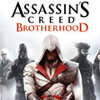 Game: Assassin’s Creed: Brotherhood
Game: Assassin’s Creed: Brotherhood
Developer: Ubisoft Montreal and Ubisoft Annecy (multiplayer)
Publisher: Ubisoft
Available on: PlayStation 3, Xbox 360 & PC (Xbox 360 version reviewed)
If you read our hands-on impressions of this title from the Eurogamer Expo, you will know that we were initially sceptical of a sequel to the amazing Assassin’s Creed II, coming only a year after that release. How could the game really improve on its predecessor and surely this was just a cash-in. Early talk of a radical new multiplayer mode that would be unlike any other console title further worried me – a quick slapdash multiplayer deathmatch wasn’t going to set the world on fire. If you read the Eurogamer article, you will also know that we were wrong. The early build of the multiplayer showed huge promise, was great fun to play, and got me incredibly excited about the full release.
So, now the game is out, boasting a full single player campaign alongside the innovative stealth multiplayer modes. Has the game skimped on substance, simply to deliver us this new online experience or can the game stand up as a full-on Assassin’s Creed canon release? Read on to find out.
STORY: Set immediately after the cliffhanger events at the end of Assassin’s Creed II, the game has strong storyline already in place to back it up. For those of you who may never have played an Assassin’s Creed title, pay attention – this gets confusing. You play as Desmond Miles, a modern-day assassin who finds himself abducted by a group called Abstergo – remnants of the Templar Knights movement, who control most of the world governments to serve their own needs. Not to give too much away, but with the use of a machine called the Animus, Desmond can regress his sub-conscious and experience his past lives. The first game in the series saw him inhabit the life of Altair – a middle-eastern man based in the holy land, working as part of an order of assassins, and in the second game Desmond took over from Ezio Auditore – Italian playboy-turned assassin, who was out to avenge a terrible act set upon his family. In going back into his past lives, Desmond and the other modern-day assassins intend to find the secrets they need in order to finally defeat the Templar order once and for all.
Phew! In this title, we start off where number two ended; Desmond and his friends are being hunted down, and find that to get to the information they need, they once again have to delve into the memories of Ezio, who it seems is still in a lot of trouble in his own time. The game goes back and forth between 2012 and the Italian Renaissance, containing playable areas in both times – but the majority of play will be carried out as Ezio. The Borgia family – of whom Rodrigo was the nemesis of the second title – are still out to destroy the assassin order, and will stop at nothing to find and kill Ezio. The player takes control as Ezio must regroup and recruit an army of his own to take control of Rome and defeat his enemies.
The story is beginning to reach Hideo Kojima levels of complexity, but that isn’t all together a bad thing. The writers succeed in interweaving the past and the future tightly, linking real-life and fictionalised events to create a narrative that is rooted in reality. The huge amount of research into the Italian era visited is clear and it pays off when famous historical figures take part in proceedings. This provides players with a further connection to the game, as we all know who Leonardo Da Vinci is. The fact the story is so based in true events may even lead some players to become more interested in the history of the period, in the same way that the Da Vinci Code made the Templar Knights a fashionable topic once again. Fictional characters have been developed well, especially if you have been following the series, and the interaction between them is entertaining and well written. Without the strong story, the gameplay elements would fall flat, and Ubisoft have obviously put in a lot of work on this front.
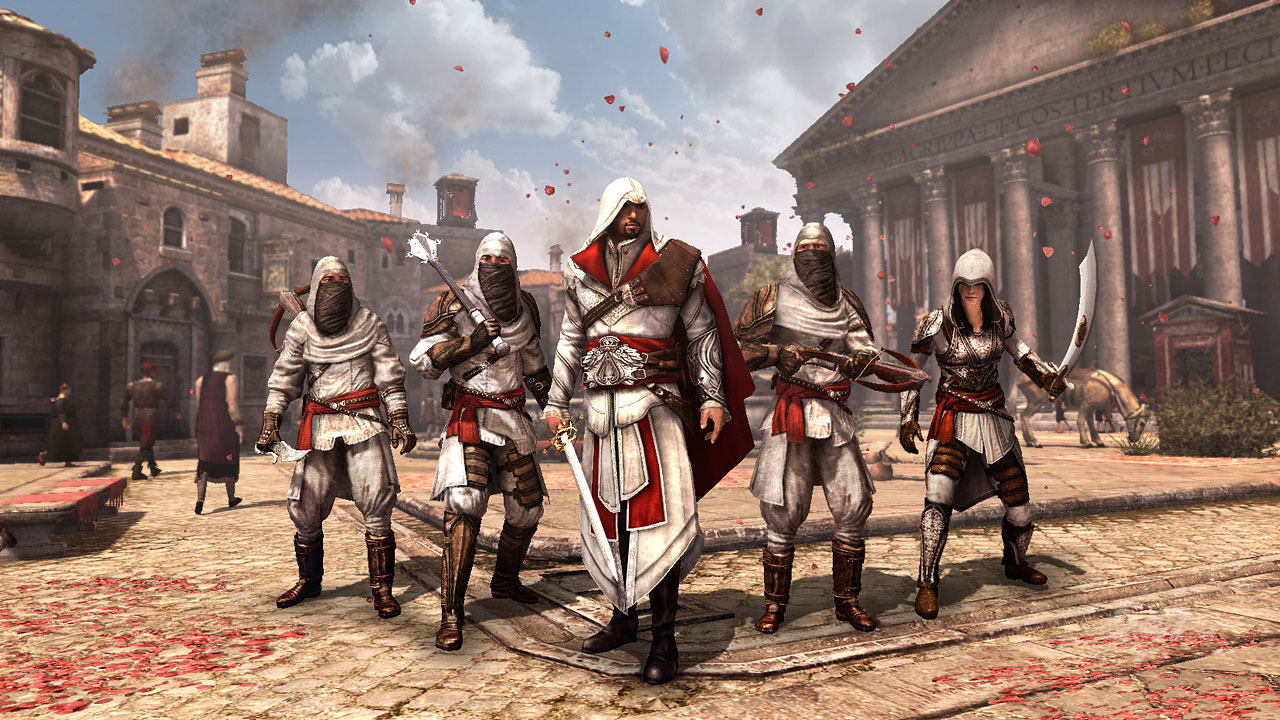
Bloody "hoodies" get everywhere these days!
GRAPHICS: There is little of note to say to those who have played previous games in the series. As this title has come so soon after Assassin’s Creed II, it is built on much the same engine as before, and not much has changed graphically. This is no bad thing, as the game remains one of the best looking titles of the current generation. The recreation of Renaissance Rome is stunning and the details of a hustling, bustling city are astounding. Many real-life landmarks are recreated in the game and although the layout of the city may not be 100% true to life, this is a very accurate interpretation of what Rome would have looked like at the time. You can tell the development team spent much time researching architecture, paintings and textiles from the time, in order to maintain a consistent and believable vision.
Character models also remain impressive – perhaps even better than before. This really comes into its own when cutscenes (using the in-game engine) are shown. The cutscenes zoom in closer to the characters, allowing you to see the incredible detail in the faces and the animations used for expressions. Most of the characters have been modelled on actors and this has created some very life-like results, without the “uncanny valley” problems, where eyes seem creepy and unrealistic, which has been a problem in some games, such as Heavy Rain. Lesser characters are obviously not afforded quite the same level of attention, as it is rare that you would see these up-close, but the general populous of the city remain convincing and do create the “living city” feeling as they go about their own business.
SOUND: Sound is a very important feature in the game, as the sound of heavy footsteps can give you away or overheard conversations can give you important clues. Again, the sound design is excellent, helping to create the atmosphere needed. Whether that be the creepy loneliness of an echoing cave, silent, but for your own movement and the drip of water from the ceiling or the noisy, busy street market – full of citizens chatting amongst themselves, town criers making proclamations and horses restlessly neighing. All of these sounds are layered together to help make the setting even more effective, but allowing you to still listen carefully and pick out particular sounds when necessary.
Voice acting is superb, most of the cast returning from the previous game – as you will have the pleasure of re-uniting with quite a few friends and foes you faced before. Spoken partially in English and Italian, the voices all seem perfectly fitted to the parts. The only problem with this that I should really mention is that during fights enemy characters such as guards and captains seem to have a very limited vocabulary. Within one fight, expect the same defiant lines of speech to be uttered by your victim several times – sometimes in quick succession. Sometimes they will even speak over their own sentences, halfway through. This is not a game-breaking issue, but it does break the illusion that these are real, thinking people, which is disappointing.
Music is once again an important aspect and a very well-executed part of the game. The score is composed by Jesper Kyd (who also composed music for the Hitman series and Kane & Lynch), returning after also scoring the two previous games. The music really helps create the mood, whether it may be adding to the tension of a stealth mission or the speed of a chase – it successfully manages to heighten the excitement. In places where the past and future overlap, so does the music – creating something that sounds modern, but incorporates the Italian roots in a clever way. Each area of the city has its own theme and because the changes in music from place to place are always blended well, this successfully alters the mood, depending on the current location. The music has been implemented in a clever way and this certainly adds to the overall experience.
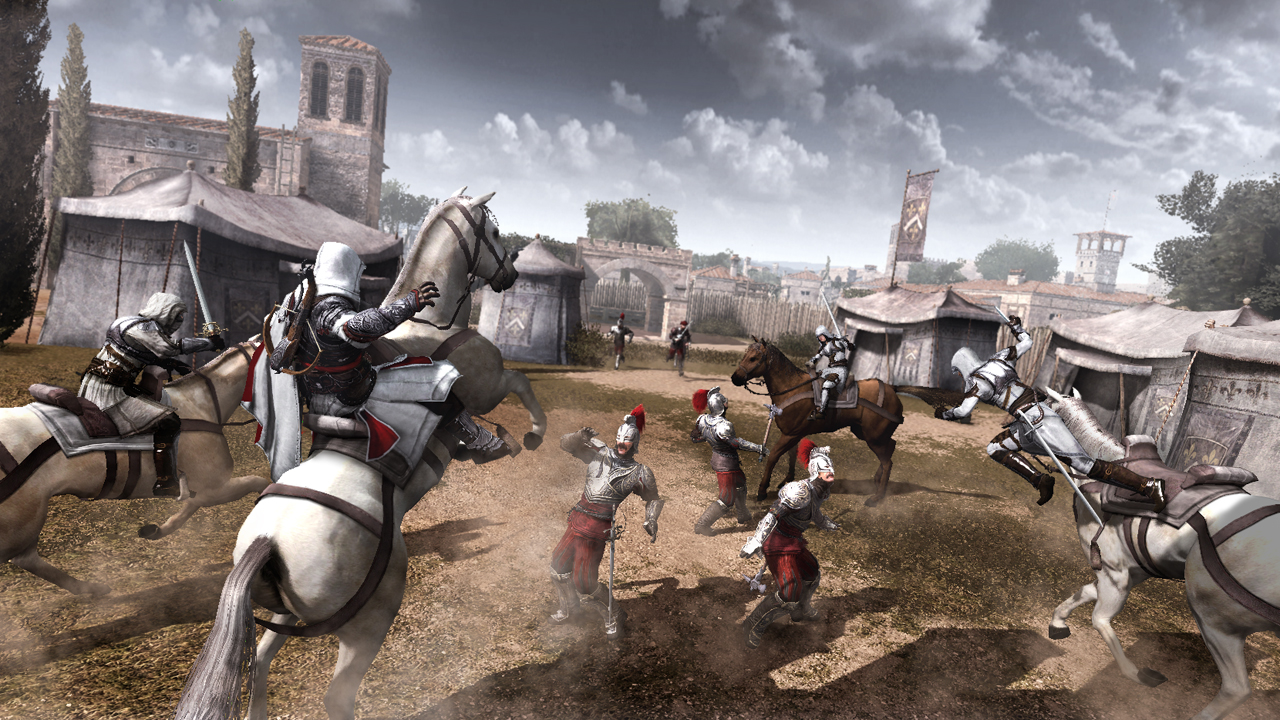
Bringing horses to a sword fight, that's just cheating!
GAMEPLAY: Ubisoft have introduced a lot of new gameplay elements for this title, but the core remains the same as before. Assassinations are handled in much the same way as Assassin’s Creed II. However, there are some new weapons or gadgets at your disposal now. After the gun was introduced last time out, we now also have the slightly slower but longer range crossbow – which is a welcome addition. This certainly helps when picking off sentries posted on rooftops and is much quieter than the gun. The other major addition to your gadget box is the parachute. This is activated easily when falling and is especially useful for those escapes when you could do with drifting away from a great height. There are some new swords and daggers to play around with also, but these make only a negligible difference to gameplay.
Fighting has been tweaked slightly again, both for the player and the enemy. Enemies can now grab you and hold onto, allowing their colleagues to get a free shot at Ezio. This can be countered or escaped by pressing the correct buttons – but can really be an irritation when it stops you mid-flow. I assume this has been added to the game because of the other new feature – kill streaks. Once you have landed a kill on one enemy, this new feature allows you to simply chain together one-hit kills on any nearby adversaries, with a simple button press. You can rack up quite massive combos, provided you are surrounded by enough bad guys. It seems that maybe the grab feature was put in place to allow the guards to break your combos – because I can imagine that if this wasn’t present, Ezio could go on huge rampages, where no-one could touch him. It seems like a balancing element.
Instead of just having viewpoints which must be scaled, this time out there are Borgia Towers. These towers are controlled by a captain and his guards, and mark a control point over the local area. Ezio cannot use shops or buy properties in the area until the captain is defeated and the player scales the tower. After the area has been freed from Borgia control Ezio can now partake in another new game feature – Renovation. Teased in Assassin’s Creed II, where the player could build up the assassin stronghold by repairing battlements and opening shops – Brotherhood takes this idea and runs with it. You can buy shops, stables, landmarks and aqueducts – for example – renovate them and open them back up. This builds up your rent and income, whilst also unlocking new items in the shops and opening up access to new areas. This will be your main source of income in the game, so you will want to quickly build up a property empire and visit the bank to withdraw your earnings on a regular basis. This is a novel way to unlock new features and makes you have to work harder for your money, but is ultimately more rewarding.
New to this game too, are Leonardo missions. Forced to create war machines for the Borgia, Leonardo needs your help to destroy these weapons of destruction and make sure they are never rebuilt. Each mission will see you venturing out of Rome, to specific locations where the vehicles or weapons are being developed, in order to stop their production. These missions add some variety into the gameplay, as land, air and water-based weapons appear – but the vehicle controls aren’t always terribly well implemented. As in the previous game, when there were carriage driving missions, the movement of the vehicles doesn’t always work particularly well, but this is only a very minor niggle that won’t ruin your enjoyment of these side-quests.
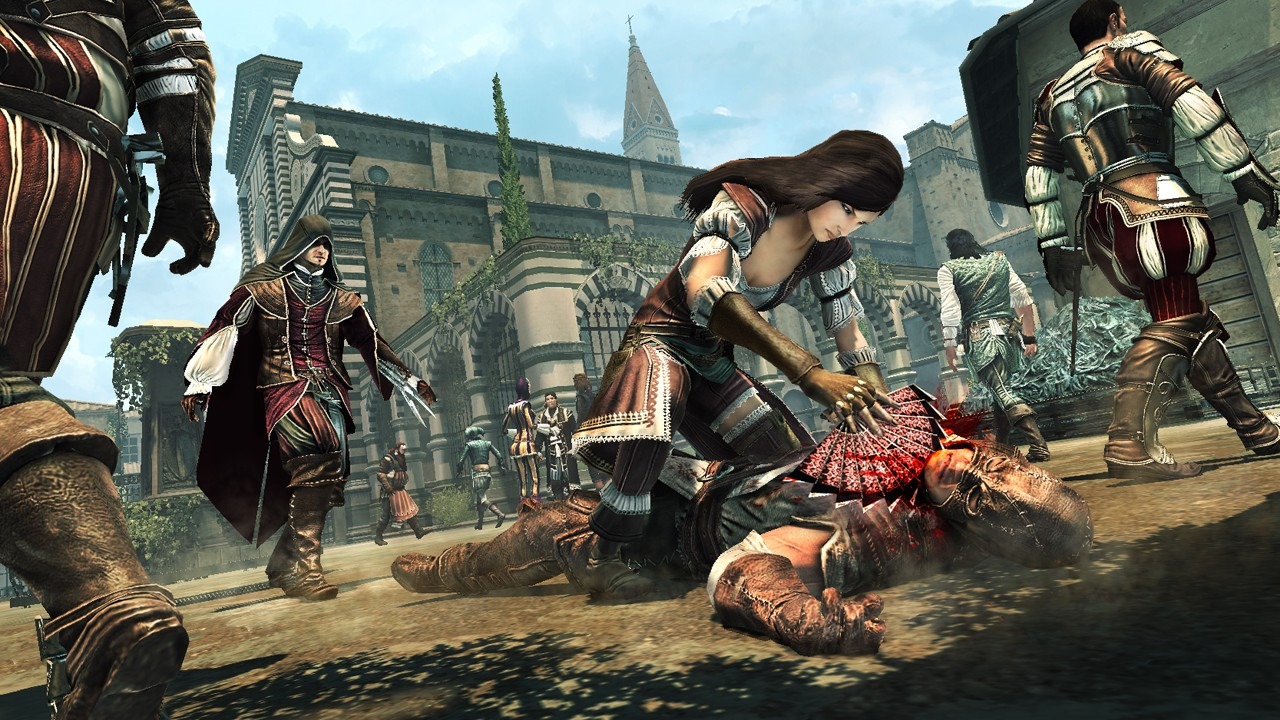
Seems like she didn't like his choice of clothes for their date...
The final major addition to the game is the assassin recruitment mode. After a certain point in the game, you unlock the ability to locate willing citizens, who are in peril with the Borgia, and recruit them to your cause. After bringing them on board, Ezio can send his recruits on missions of varying difficulty, around Europe – by way of a map screen. Competing missions gains money and XP, which can then be used to level up the trainees and to give them more armour or weapons. As they become more experienced they can take on harder missions, with the aim of becoming a fully-fledged assassin. This is not the only use of your students though. In the main game, assassin recruits can also be called upon to help you out. By targeting enemies and pressing the correct button, you can order them to swoop down on the target and take them out or fire a hail of arrows to stop them in their tracks. This is particularly handy when you know that if anyone sees you, the mission will be failed, but you need to dispose of someone. Obviously, the better you have ranked up your team, the better they will perform in-game and the more of an asset they become. It must be said, it is immensely satisfying to be able to get someone else to do your dirty work for you when you are in a tight spot – allowing you to go about your business as if nothing happened. Whilst this can be enjoyable, it also serves to simplify the game, and take away some of the challenge. For instance, during a particularly tough mission where you must not be detected, the use of your recruits will provide the easy way out, as it were.
MULTIPLAYER: Having already covered this to a degree in my hands-on impressions, I won’t go into huge detail into the mechanics of the multiplayer. It’s simply a case of players trying to assassinate each other after being given a contract. The contract will only show what the target looks like, but AI characters using the same character model will also be present in the game, so you have to make sure you kill the correct barber, for example. By reading the actions of the characters and by using your Alien-style beeping radar, you have to suss out who your mark is and find them before they know you are after them. The other side of the coin is escaping once you know someone else is trying to kill you. This can be done by using gates to block their path, using hay bales to hide and even by knocking them out before they manage to kill you.
The game contains four multiplayer modes; Wanted, Advanced Wanted, Alliance and Manhunt. The two Wanted modes are solo modes, for up to eight players. You will be assigned a target to assassinate, whilst at least one other assassin is simultaneously trying to kill you. You are awarded points based on how stealthy your kill is or how acrobatic. You also gain points for successful escapes. The difference between the two is that in Advanced Wanted, the compass which helps you locate your target is harder to read and will not let you know if a player is on a higher or lower level of building than you are.
Alliance and Manhunt are both team-based. Alliance sees three teams of two carry out play in much the same way as Wanted, with each team given another team to hunt, but also being hunted by the third team. The players must work together to detect and avoid enemies and score the most points. Manhunt sees players split into two teams – one the hunters, one the hunted. The round is played out and one team scores points for kills, the other for avoidance. After an allotted time, the two teams switch roles and the team scoring highest after both rounds is the victor.
The modes do offer a good variety in play – with Manhunt being much more frantic in my opinion, but no less fun for that. These modes do replicate the feel of the main campaign mode faithfully, whilst creating an online experience that is quite different from any other. This is what the multiplayer in Metal Gear Solid 4 should have been like. Unfortunately, the quality of your gaming experience will differ depending on who you play with – as always. Some will play Brotherhood in the spirit it was intended – stealthily sneaking and deducing who to kill. Some others players won’t get it and you will frequently see some people running full pelt all over the map like a headless chicken. Luckily, more points and rewards are awarded for killing silently, so these players will no doubt end up at the bottom of the final rankings as they are giving the game away too much.
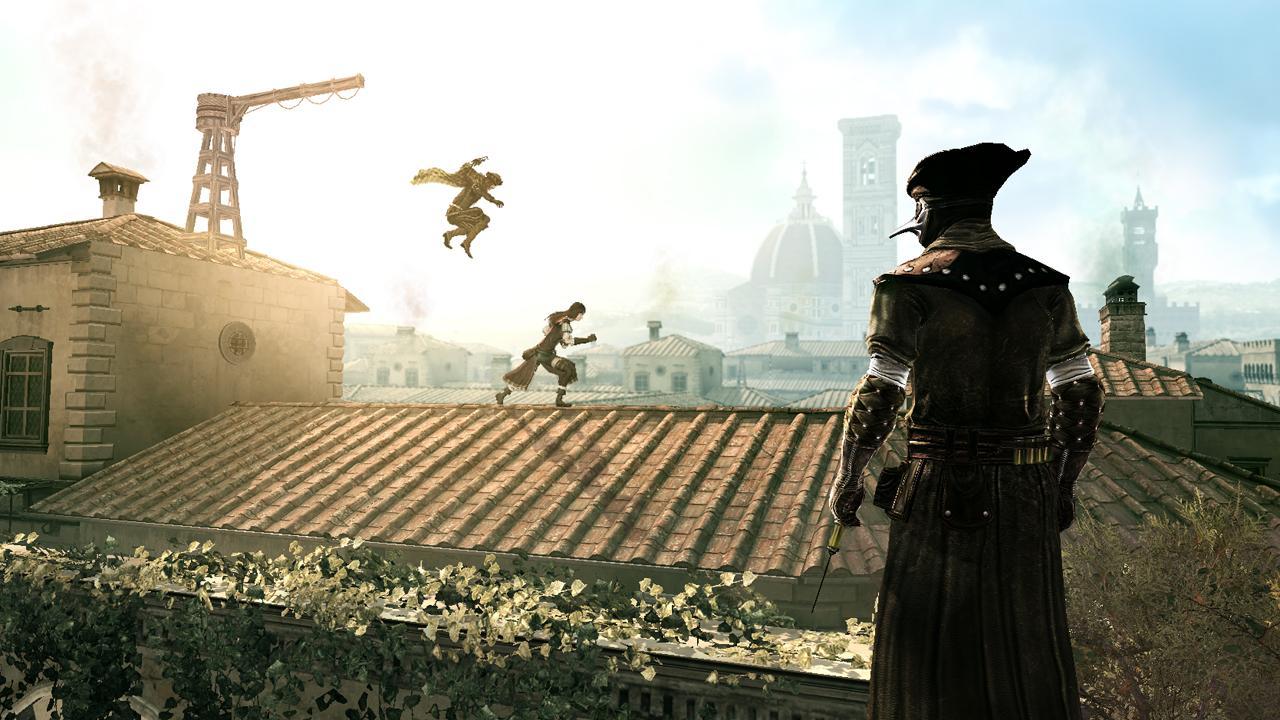
Sick act of voyeurism or just silent observation?
In terms of performance, the multiplayer aspect runs very well. Even with fairly low-speed broadband, the game runs smoothly and lag is kept at a minimum. Cleverly, Ubisoft has limited online modes to eight players and considering the highly detailed maps used for multiplayer, this does result in a pleasing level of operation. Graphical errors are at a minimum and it is easy to forget that this is an online-based mode. That is the measure of how well the system functions. Sometimes death animations will occur when you think you have escaped or are floating in mid-air, but these are few and far between and will not reduce the enjoyment of the game.
Further replayability is added through levelling up your multiplayer avatar. The points you score in a round are translated to XP, which then levels you up. Ranking up unlocks new playable skins, gadgets and skills to use in-game, for example. The ability to disguise yourself as a different character is one, the use of the gun or smoke bombs in multiplayer are others. You are limited to how many skills can be used in one session, but as you level up, more skill slots will unlock and you can manage your skill profiles to work out the best mix of skills for each situation you play in. There are also extra objectives you can work on in each round – such as kill five enemies silently – which will gain added XP and help level you up faster. This ranking system will encourage users to play more, so they can open up the skills they most want to use and create the perfect fighting machine.
LONGEVITY: The multiplayer has some good life in it, due to ranking and progression, but so too does the single player campaign. The second game in the series was huge and lasted a long time from start to end, this game is no different. The main campaign is massive, and will take many hours to play through if you ignore all extraneous distractions. There were complaints levelled at the second title that it was too easy. In an attempt to remedy that and also add a tiered difficulty system, Ubisoft have included extra objectives. Each mission can be completed at either 50% or 100% synchronisation. To attain 100%, there will be an added condition that must be met, which will undoubtedly make your task more difficult. One might be that everyone must be killed using the hidden blade, or that the mission must be finished in under 90 seconds. This provides an extra level of challenge, but the fact that it is optional is a very clever idea, as the individual player can pick and choose their own level of challenge as they go – so you can opt for hard or easy, depending on the mission.
There are many side-quests which can be accessed between the more story-driven missions and there is a lot of variety in the content. The diversity of actions is paired with the same storytelling flair shown in the main game – side missions still add to the back-story or canon of Assassin’s Creed and add to your overall immersion into the world. It is not like some games which simply tack on missions which have no relevance to the main game.
Alongside these you have a myriad of collectables. Flags, feathers and treasure chests are scattered throughout Rome and can be collected for achievements/bonus items. Locating them could become frustrating, but many are littered around in areas you are bound to walk through and maps can be purchased later into the game to help you track down the elusive ones you still need. This is a marked improvement from the last game where around one hundred feathers were scattered throughout the towns, with no way to locate them all on the map. Attaching achievements and unlockable items to these collectable items ensure that many players will want to track them down, and this will add many hours to your overall playing time.
VERDICT: Whilst many may look at the title and still wonder why some of this wasn’t included last time out, or why Rome wasn’t released as a downloadable add-on, the improvements made to fighting and the new features added to the game refine an already great experience. When you first begin to play, this certainly feels like more of the same, but you will welcome the return of the likeable Ezio and as you progress further into the game. The additions enrich the game and make it stand out from what came before. The side missions are more interesting and compelling than before, renovating towns is a nice feature and the recruitment and deployment of assassins adds a sprinkle of strategy into the mix. The single player may not break new ground, but it has polished the gameplay hugely.
The multiplayer wasn’t just an afterthought. It has been implemented cleverly and is a clear extension of the core gameplay. Sure, this should have been included in Assassin’s Creed II, but maybe then it wouldn’t have been this good. Whereas a lot of game series might struggle with their first foray into online gaming, this is an assured step. What you know from solo play translates directly into the online play and it really is a natural progression.
For those who haven’t played any of the previous games in the series, you might want to play Assassin’s Creed II before you venture into Rome. However, make no mistake about it, Assassin’s Creed: Brotherhood is still one highly enjoyable standalone product – a must for fans of the series and genre alike. Not bad for a game initially touted as a “stop-gap” and “money-spinner”, not bad at all.






